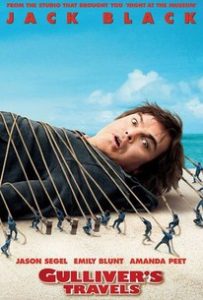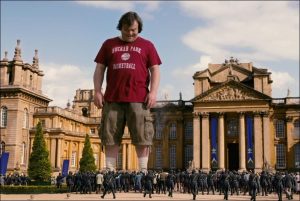
Film Adaptation of Gulliver’s Travels: Similarities and Differences
Gulliver’s Travels was written during the eighteenth century by the author, Jonathan Swift. Since then, there have been a few films produced reenacting the tale of Gulliver on his voyage to Lilliput and his adventures there. The original tale is somewhat different than what the film shows and it’s interesting to notice as well as analyze those differences to see how the outcome of the story differs from the film.
The film production that I watched was Gulliver’s Travels, the 2010 version starring Jack Black. The movie overall followed the general story line of the book, but most of the details within the movie were completely different. I will go through the film in chronological order, depicting the similarities and differences as they appeared in the movie.
The film started out with Gulliver working in the mailroom. He was what you could consider “lower class” which would be the same class as Gulliver from the original story version. Being that the movie is very new, the entire production was very modernized. When discussing the similarities, the movie was not always identical but it was similar enough to keep the central idea of the book. When Gulliver is working in the mailroom, he is upset that he isn’t doing much with his life and he works for people who are much higher up than he is. He has a crush on a lady named Darcy, who he delivers mail to and that is where his adventure begins. He goes to ask her out on a date, yet chickens out and makes an excuse as to why he was in her office. He grabs a file on her desk saying he just came to pick it up. She explains to him that it is paperwork for a trip to the Bermuda triangle for an article to write. He says he can easily write and that he will take the trip. He plagiarizes his writing to show her that he can write rather well. He leaves for the trip the next day. He receives his own boat called the “Knot For Sale” and he sets off to the Bermuda Triangle. The entire beginning of the movie is different than the book being that it is so modernized. The book never showed a love interest, and in fact, within the book, it says that Gulliver got married before his voyage to a woman named Mary. Another interesting difference was the name of Gulliver’s boat. In the movie it was “Knot For Sale” to show some humor. In the book his boat was named “Antelope”. In the film, Gulliver said that he had never traveled before but told Darcy that he had in order to impress her. The book states that Gulliver in fact went on many voyages prior to the once discussed and was very interested in navigation and adventure.
Both the book and the movie had Gulliver set out on his voyage and had a massive storm hit leading Gulliver to wake up on the island of Lilliput. Both the book and the movie showed how the Lilliputians tied him up and were walking all over him. An interesting note to make was that the people of Lilliput within the book did not speak the same language as Gulliver. The first words they said in the book was “Hekinah Degul”. In the movie they spoke English probably to make the film easier to follow. The story continues and eventually the Lilliputians trust Gulliver when he saves them from an attack from their rivals. In the movie they brag about their skills in building and they build Gulliver and entire palace. The book also mentions their skills in architecture by saying “these people are most excellent mathematicians and arrived to great perfection in mechanics”.
Later on within the movie, Lilliput is attacked and the building is set on fire. Gulliver urinates on the building, stops the fire and saves Lilliput. In the book, the same thing happens except for Gulliver is charged with treason and public urination. The movie did not have any of this happen and they praised him even more. The book explained the differences that Lilliput had with their enemies and explained the factions. The movie never once mentioned this and I think that the factions were an important part of the story and shouldn’t have been left out. Gulliver is then banned from Lilliput because he is charged with lying about certain adventures that he told everyone that he went on so they ban him and take him to be a prisoner at Brobdignag, the land of the giants. The only thing in the movie that happened there was he was in a dollhouse of a giant child. His Lilliput friend comes and rescues him and they go back to Lilliput. Gulliver then apologizes and defeats a nasty leader in Lilliput and he is forgiven. He ends up getting his woman, Darcy after she goes on the voyage and ends up in Lilliput too. The two leave and go back to their home in New York and Gulliver ends up moving up in his workplace and there’s a happy ending. The books ending was not anywhere near this ending. The book went on to say all of the voyages he went on and ended up with completely different outcomes.
There were very few similarities when looking at the detail of the whole story. Overall the movie followed the basic story line of a man named Gulliver who ends up in a storm and finds himself on the island of Lilliput with the small people. The movie tried to be much more comical and modern which is understandable, but it did not do a great job depicting the story and keeping it close to the same as the book. There were many more differences to note throughout the movie but these were just the main points that helped develop the story. The book is a satire, which is a “work that blends censorious attitude with humor and wit for improving human institutions and humanity”. The movie followed this rather well, but was definitely more comical than the book. Being that the film was so modernized, it could be hard for one to grasp the major concepts that the story included, such as the factions, just for one example. The story itself is very explanatory as well as the movie, however when comparing the two works together they don’t exactly resemble each other to a long extent, nor do they help a reader/watcher understand the plot any better.


